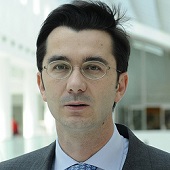Spanish Soccer Teams and Sovereign Wealth Funds
Are sponsorships of sports clubs beachheads for sovereign wealth funds’ investments in the West's national champions?
January 10, 2011
While the Spanish cyclist Alberto Contador won the Tour de France again in 2010, the winning team has been a sovereign wealth fund. The power of the purse behind Astana, the cyclist’s team, is really Kazakhstan’s sovereign wealth fund, Samruk-Kazina.
This is yet another example of the power the emerging economies are gathering. In this case, one from Central Asia, a former satellite state of the Soviet Empire, converted itself into an independent energy power following its liberation after the fall of the Berlin Wall.
The example of Astana is not an isolated case. In the English football league, it was rumored halfway through 2010 that a Chinese sovereign wealth fund (CIC) would be interested in shares in the Liverpool football team.
It is not the first time such rumors have been spread. Middle Eastern sheiks, Russian oligarchs and Asian multi-millionaires have already poured money into the English Premier League and other European football leagues.
To boot, Fly Emirates, the airline company owned by the Government of Dubai, has sponsored half a dozen European football clubs, among them AC Milan in Italy (with an estimated investment of €50 million made at the beginning of 2010 for four seasons), Olympiakos in Greece, Hamburg in Germany, Arsenal in England and Paris Saint Germain in France.
Nor have Russian oligarchs and companies missed the train. The energy giant Gazprom has invested a record €125 million in the German club Schalke04, which Real Madrid player Raul recently signed for in 2010.
Gazprom also sponsors Zenit Saint Petersburg in its own country. For its part, the South Korean multinational Samsung has invested €14 million in the English club Chelsea, owned by the Russian oligarch Roman Abramovich.
One wonders when Real Madrid or Barça will receive sponsorship from emerging countries — and from whom? Perhaps a Brazilian multinational, such as Petrobras or Vale, will step up to the plate, looking for global image or renown.
Or one from China, like Sinopec (which has just bought a 40% stake in Repsol Brasil), Chery (which intends to build its first industrial plant in Europe) or Geely (now the owner of Volvo). Or an Indian multinational, such as Tata or Reliance, with strong interests in Europe.
At the end of 2009, Real Madrid had actually taken a step in this direction, reaching an agreement with the Saudi Telecom Company (STC) that turned Saudi Arabia’s leading telecommunications operator into the Club’s international sponsor. Strangely enough, its rival, Barça, also has an Arab telecoms operator amongst its international sponsors, the giant Etisalat.
These sponsorships will not only improve the respective clubs’ finances, but could also whet their appetites for investing in national companies in the target markets. What is interesting is that these football investments appear to effectively stimulate, or go hand-in-hand with, other industrial investments.
For example, the Libyan sovereign wealth fund Libyan Investment Authority (LIA) invested in the Italian club Juventus (it has a 7.5% stake in the shares controlled by the Agnelli family, owners of the FIAT group).
Libya’s interest in the Italian club coincided with the wish of their sovereign wealth fund to become a stakeholder in different Italian multinationals. It has, in fact, become one of the main new sources of financing of corporate Italy.
In Spain, it also bought into shares of companies like the Italian bank Unicredit in July 2010 (it holds a 7% stake along with the Libyan Central Bank, making the Libyan government the second largest shareholder in the bank after the Italian government), or the oil company ENI (it has a 2% stake in the Italian oil company that, in turn, exploits Libyan oil sites, as does the Spanish company Repsol).
It created a common investment fund with the investment bank Mediobanca in order to have a stake in Italian companies undergoing financial difficulties. LIA also reached an agreement with the aerospace group Finmeccanica in 2009, a year in which many rumors circulated about LIA buying into shares of Telecom Italia and ENEL (which controls Endesa in Spain).
LIA is not the only vehicle of sovereign investment to have a stake in Italian companies. For its part, Aabar Investments, a fund from the Emirates, also bought into the Banco Santander affiliate in Brazil.
These examples are part of an underlying trend reflecting the acquisitive drive of emerging markets.
Given all that, it is easy to imagine sponsorship of Real Madrid by ADIA, one of the largest sovereign wealth funds in the world, located in Abu Dhabi, in the Emirates, and its logo on the club’s shirts.
Why not imagine that its rival, Temasek, the sovereign wealth fund of Singapore, does the same with Barça’s shirts? Or the Chinese sovereign wealth funds SAFE and CIC, the largest of their kind in the world?
This could lead to these funds (or other similar ones) also taking a more detailed look at the Ibex 35 companies and thereby helping to draw attention and long-term capital to Spanish multinationals.
Editor’s Note: This article is based on a paper by Javier Santiso titled “The Emerging World Champions” for ESADE Center for Global Economy and Geopolitics, published in October 2010.
Takeaways
International sponsorships will not only improve the respective clubs' finances, but could also whet their appetites for investing in national companies in the target markets.
The energy giant Gazprom has invested a record €125 million in the German club Schalke04, which Real Madrid player Raul recently signed for in 2010.
In the English football league, it was rumored halfway through 2010 that a Chinese sovereign wealth fund (CIC) would be interested in shares in the Liverpool football team.
Read previous
Tariq Ramadan on Diversity of Religion
January 8, 2011
